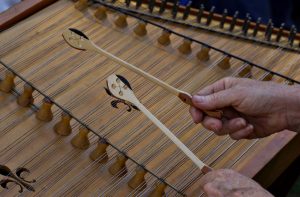 Mountain Dulcimer
Mountain Dulcimer
The Mountain Dulcimer is a true American instrument. It dates back to the early 1800’s, originating in the Appalachian mountains of southwest Virginia.
Western Europe had many kinds of fretted lap zithers from the Norwegian Langeleik, the Swedish Hummel, and the French Epinette. But it is the German Scheitholtz that is considered to be the forefather of the modern Dulcimer.
German immigrants brought their Scheitholtz with them when they settled in Pennsylvania. The Scheitholtz then worked its way down south along the Philadelphia Road into Virginia. Here a Scheitholtz was place on a larger sound box providing a transition between the Scheitholtz and the Dulcimer. It was further south along the Wilderness Road in southwestern Virginia that the Dulcimer we know today was born. Someone experimented with the Scheitholtz and simplified it. They took just the fretted fingerboard of the scheitholtz and put it on a larger sound box. These Virginia dulcimers were teardrop shaped with 4 strings.
Later after the Civil War, the Dulcimer found its way further along the Wilderness Road into West Virginia and Kentucky. Eventually, the Dulcimer made its way into all of Appalachia including the Carolinas and Tennessee. Each maker added his own flair and sound hole pattern.
The Appalachian Mountains were settled by the British, the Scottish, and the Irish. These people claimed the Dulcimer as their own even though they never had a musical instrument like the Mountain Dulcimer back home in the British Isles. That is why so many British, Scottish, and Irish tunes are played on the Dulcimer.
In the mountains, this new instrument was given the name of “Dulcimore” (later changed to Dulcimer). Dulcimer comes from the Greek meaning “sweet song”. Not to be confused with the much earlier hammered dulcimer (which is a Persian instrument called a Santur and is the forefather of the piano). Both were named for the sound they produced and not any relationship. Thus the Mountain Dulcimer with its sweet sound was perfect for playing the old-time tunes of the mountains.
 Hammered Dulcimer
Hammered Dulcimer
To most modern Americans, the hammered dulcimer is a new and unfamiliar instrument. Even people who know much about American music often confuse the hammered dulcimer with the three- or four-stringed “mountain” or “plucked” dulcimer. The two instruments are very dissimilar despite sharing a name. Surprisingly, the hammered dulcimer, which is an ancient ancestor of the piano, at one time enjoyed widespread popularity throughout this country.
The hammered dulcimer probably originated in the Middle East about 900 A.D. and is related to the much older psaltery. It spread from there across North Africa and was brought into Europe by the Spanish Moors during the 12th century A.D. It is possible that hammered dulcimers were played even earlier than this in Ireland, where they were called “tympanons.”
Throughout the late Middle Ages and the Renaissance, the dulcimer remained a popular instrument in both eastern and western Europe. It was known by different names in different countries. For example, the dulcimer was called a “tympanon” in France, a “hackbrett” in Germany, and a “cymbalon” in Hungary. In England it was so popular during the late 16th century that the translators of the King James version of the Bible used the term “dulcimer” as the English translation for the Greek “symphonia.” This term was actually a mistranslation for a type of Greek bagpipe that gave rise to the often quoted, but incorrect, belief that the dulcimer is as old as the Bible.
It is unclear when the first hammered dulcimer was brought to America, but the earliest reference to its use in this country comes from Judge Samuel Sewall who wrote of seeing one played in Salem, Massachusetts, in 1717. Hammered dulcimers are particularly interesting because, unlike the piano, dulcimers were often built at home, or in small shops and factories, and hence tended to reflect differing regional and personal folk styles. During the 19th century, these small shops, which usually employed less than a half-dozen craftsmen, operated in places like Norwich, Connecticut, Chautauqua County, New York, and Brooklyn, New York. Mail order companies (e.g., Montgomery Ward) also sold dulcimers.
Why the dulcimer virtually disappeared during the first half of the 20th century is something of a mystery, but possibly it was due to competition from the more fashionable piano. Fortunately, this beautiful instrument is now enjoying a revival. For the first time in many years, new dulcimers are being built, and there is an increasing number of new players.
*Smithsonian. Retrieved from http://www.si.edu/Encyclopedia_SI/nmah/dulcimer.htm
 Mountain Dulcimer
Mountain Dulcimer Hammered Dulcimer
Hammered Dulcimer